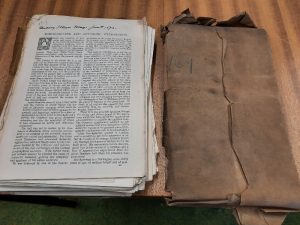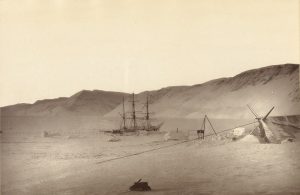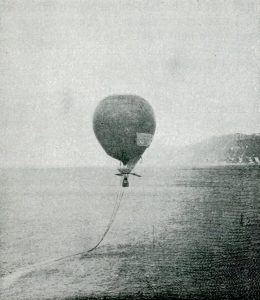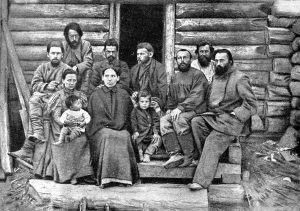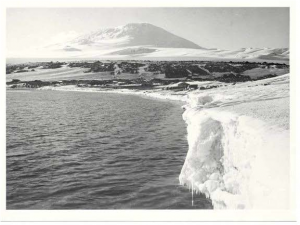
Polar exploration
Work is continuing in the Royal Commonwealth Society Library department to catalogue its collection of nineteenth- and early twentieth-century pamphlets and magazine articles. The latest volume to be completed is devoted to the theme of Polar exploration. Pamphlet volume 169, like so many others in the collection, barely escaped destruction when the RCS London headquarters was bombed during the Second World War. On the night of 16 April 1941 it was hit by a two-ton high explosive bomb, which killed a society member, and the blast and fire damage destroyed approximately 40,000 books and pamphlets. A few examples of the damage caused by the bombing have been preserved, including the brown paper wrapper which housed Pamp. 169. The image to the left shows heavy soot deposits upon the wrapper and how well it protected its contents.
Pamp. 169 draws together nearly forty works dating from 1893 to 1908, charting one of the most dramatic periods of attempts to reach the North and South Poles and to learn more about the geography of the Arctic and Antarctic regions. Most were published in the general periodical press, seeking to mobilise support for expeditions and reporting upon their achievements, many written by leading explorers themselves. They reflect the intense national and personal rivalries inspired by the races to be the first to the poles, and how they fired the popular imagination in America, Britain and Europe.
The works document early voyages towards the North Pole, beginning with the Norwegian Fridtjof Nansen’s attempt to drift there along with the ice flows in the specially reinforced vessel Fram, which departed from Oslo in 1893. In March 1895, Nansen disembarked when it became clear that Fram’s course would not carry it to the pole, and travelling with kayaks and dog sledges, set a record northerly latitude before turning back. The publications trace attempts by the American Robert Peary to push to the pole from Ellesmere Island by dog sledge in 1902 and 1906. Coverage concludes with Frederick Cook’s now discredited claim of having journeyed to the pole by sledge from the northern coast of Axel Heiberg Island in 1908. There were also missions to reach the North Pole by air. In 1897 the Swedish balloonist Salomon Andrée attempted to fly over it, but his hydrogen balloon crashed soon after launching from Svalbard, and he and his two companions perished while trying to return. The RCS holds the archives of one of the pioneers of civil aviation, Sir Frederick Tymms, who led the Air Section of the Oxford University Arctic Expedition to Spitsbergen in 1924.
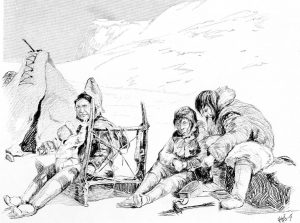
In addition to scientists, expeditions included artists to record the stunning natural beauty of the polar land and sea scapes, and their inhabitants, including the American Frank Stokes, who travelled to northern Greenland with Peary and the Antarctic with Otto Nordenskjold. The Arctic explorers received invaluable assistance from the indigenous peoples of northern North America and Europe, who acted as guides, and taught them how to survive and travel in such a harsh climate. Explorers such as the Norwegian Eivind Astrup, who mapped Greenland during Peary’s expeditions, wrote about Inuit language and culture. A traveler along the Trans-Siberian Railway to the Bering Strait left an account of Siberia’s indigenous peoples and a visit to a remote prison for Russian political exiles.
Pamp. 169 charts parallel missions to travel to the South Pole, beginning with the British expedition led by the Norwegian Carsten E. Borchgrevink (1898-1900), which became the first party intentionally to winter upon Antarctica. Many of the earliest sailors to the southern seas had been whalers and Borchgrevink had first visited Antarctica on a whaling voyage in 1894. The RCS holds important photograph collections recording the whaling industry and its bases at South Georgia and the South Shetland Islands. After his expedition, Borchgrevink served on the National Geographic Society mission sent to Martinique in 1902 to report upon the volcanic eruption of Mont Pelée.
There is extensive coverage of Robert Falcon Scott’s expedition in ‘Discovery’ (1901-1904) and the early stages of Ernest Shackleton’s search in ‘Nimrod’ (1907-09). Scientific research featured prominently in the expeditions, exemplified by the Swedish Antarctic Expedition led by geologist Otto Nordenskjold (1901-04). During the Scottish National Antarctic Expedition (1902-04) William Bruce discovered the ridge linking the continent with South America, while geologists working with Shackleton located the South Magnetic Pole on January 16, 1909. The international nature of exploration in these years is emphasised by two French expeditions to the Antarctic led by Jean-Baptiste Charcot (1904-07 and 1908-10). The discovery of the South Pole by the Norwegian Roald Amundsen on Dec. 14 1911, and the tragic return of Scott’s mission, which reached it soon after, lie just outside the scope of this volume, but are well represented elsewhere in the RCS collections.
All of these publications can be searched for on iDiscover using thematic and geographical keywords, or Library of Congress subject headings.

